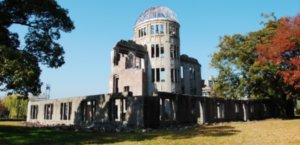COMING SOON HOUSE ADVERTISING ads_leader

 Hiroshima Dome
Hiroshima Dome
One of the few building left standing after the explosionHiroshima - On August 6, 1945, the city of Hiroshima was the target of the first atomic bomb used against civil population in history. Three days later, the United States dropped a second atomic bomb over the city of Nagasaki. In total, about one fourth of a million people were killed by the two bombs.
The Peace Memorial Park - was built to commemorate the dropping of the atomic bomb over Hiroshima on August 6, 1945 and to promote a peaceful world. It is located in the area around the atomic explosion's epicenter, and houses the Peace Memorial Museum and many other a-bomb related monuments.
The Atomic Bomb Dome - is one of the few buildings around the explosion's epicenter that partially survived the blast, and the city's only remaining bomb damaged building. The former Industrial Promotion Hall is now an UNESCO World Heritage Site.
Miyajima (literally "shrine island") - has been celebrated as a sacred island and one of Japan's three most scenic views. It is most famous for Itsukushima Shrine, which, together with its large wooden torii (gate), stands in the ocean during high tide.
Sadako Sasaki was a Japanese girl who lived near Misasa
Bridge in Hiroshima, Japan. Sadako was a victim of the atomic bomb dropped on Hiroshima and was only two years old on August 6, 1945. At the time of the explosion she was at home, about 1 mile from ground zero. Ten years later she was diagnosed with leukemia, which her mother called "an atom bomb disease."
In November 1954, lumps developed on her neck and behind her ears. In January 1955, purple spots started to form on her legs. On February 18, 1955 she was diagnosed with leukemia. She was hospitalized on February 21, 1955 and given, at the most, a year to live.
On August 3, 1955, Sadako saw a gift of 1,000 origami paper cranes that were donated to the hospital from the people of Nagoya as a "Get Well" gift. Inspired by the cranes, she started folding them herself, spurred on by the Japanese saying that one who folded 1,000 cranes was granted a wish. A popular version of the story is that she fell short of her goal of folding 1,000 cranes, having folded only 644 before her death, and that her friends completed the 1,000 and buried them all with her.
This comes from the book Sadako Sasaki and the Thousand Paper Cranes. An exhibit which appeared in the Hiroshima Peace Memorial Museum stated that by the end of August, 1955, Sadako had achieved her goal and continued to fold.
Though she had plenty of free time during her days in the hospital to fold the cranes, she lacked paper. She would use medicine wrappings and whatever else she could scrounge up. This included going to other patients' rooms to ask to use the paper from their get-well presents.
During her time in hospital her condition progressively worsened. Around mid-October her left leg became swollen and turned purple. After her family urged her to eat something, Sadako requested tea on rice and remarked "It's good." Those were her last words. With her family around her, Sadako died on the morning of October 25, 1955.
After her death, Sadako's friends and schoolmates published a collection of letters in order to raise funds to build a memorial to her and all of the children who had died from the effects of the atomic bomb. In 1958, a statue of Sadako holding a golden crane was unveiled in the Hiroshima
Peace Memorial, also called the Genbaku Dome. At the foot of the statue is a plaque that reads, This is our cry. This is our prayer. Peace in the world.
There is also a statue of her in the Seattle Peace Park. Sadako has become a leading symbol of the impact of a nuclear war. Sadako is also a heroine for many girls in Japan. Her story is told in some Japanese schools on the anniversary of the Hiroshima bombing. Dedicated to her, people all over Japan celebrate August 15 as the annual peace and love day
COMING SOON HOUSE ADVERTISING ads_leader_blog_bottom
Tot: 0.164s; Tpl: 0.013s; cc: 15; qc: 64; dbt: 0.0556s; 1; m:domysql w:travelblog (10.17.0.13); sld: 1;
; mem: 1.2mb

 Hiroshima Dome
Hiroshima Dome